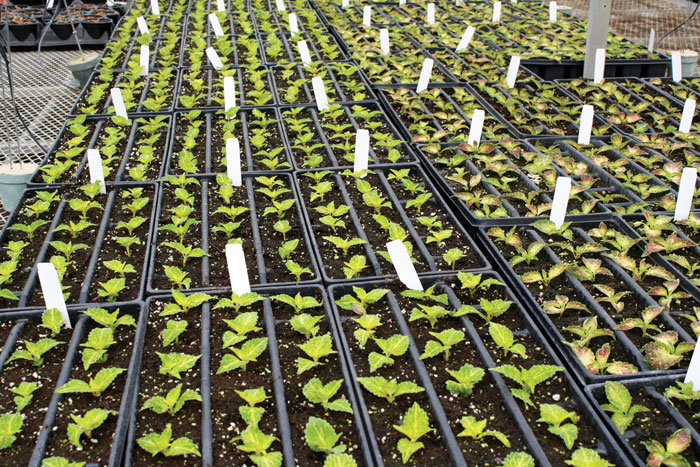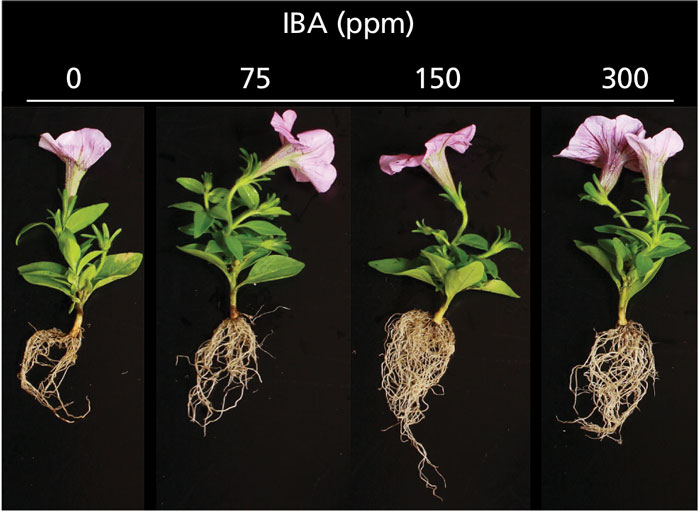11/1/2020
PGRs for Liner Production
Christopher J. Currey

With the spring season coming, it’s propagation time. The popularity of vegetatively propagated annual and perennial garden plants increases every year. There are several attributes to what a high-quality liner usually consists of, including a well-developed root system with healthy, attractive foliage (Figure 1).
Figure 1. Producing a high-quality liner takes a lot of effort, from sticking to toning. There are several PGRs with applications perfect for propagation.
For many crops, it’s also desirable to have liners that are free of flowers and with breaks or branches started. With all of these goals in mind, look to what tools there are to help. Plant growth regulators (PGRs) are widely used in greenhouse crop production, most ubiquitously for controlling stretch. But there are several other PGRs with active ingredients that can promote rooting or branching, or inhibit leaf senescence or flowering.
Promoting root growth
One of the first and primary objective when producing liners is to achieve root initiation and development as quickly and uniformly as possible. The ability of different species varies, from easy to hard to root. For those species that initiate roots more slowly, using a rooting hormone containing auxins, such as indole-butyric acid (IBA) or naphthalene-acetic acid, will jump-start root initiation. Additionally, even for those species that root readily, the use of rooting hormone can help improve the uniformity in rooting across these species, too.
The most familiar method of applying rooting hormone is by dipping cuttings into auxins suspended in talcum powder (or “talc”). Another similar formulation is when auxins are suspended in an alcohol solution that cuttings are dipped into. Whether talcum powder or alcohol solutions, dipping cuttings into rooting hormone is the most traditional way to apply auxin to promote rooting. But dipping cuttings into rooting hormone takes labor.
Recently, a labor-saving alternative has arrived. Advocate (Fine Americas) and K-IBA (Hortus) are both rooting hormones designed to be applied as a foliar spray after sticking. Concentrations between 100 and 300 ppm are most appropriate for foliar spray applications (Figure 2), with the higher concentrations for harder-to-root species. The major benefit with these rooting hormone formulations made for foliar sprays compared to the alcohol or liquid suspensions is the labor savings from application methods. Using foliar sprays can dramatically reduce the time it takes treat plants with auxin and the sticking lines will speed up as a result.
Preventing flowering
Flowering is essential for marketing finished annuals and perennials, but it can be problematic during propagation. Many vegetatively propagated annuals have been bred to flower quickly and without photoperiodic control. This is great for making it easier to get crops into flower during finishing. But the early flowering during propagation can divert energy that could otherwise be put into root growth and spent flowers are only going to contribute to disease problems.
 Figure 2. Rooting hormones formulated for foliar spray applications can reduce labor compared to traditional dip approaches, while still successfully promoting root growth and development. These petunia cuttings were treated with foliar sprays containing 0 to 300 ppm indole-butyric acid (IBA; Advocate, Fine Americas) after being stuck and placed in the greenhouse.
Figure 2. Rooting hormones formulated for foliar spray applications can reduce labor compared to traditional dip approaches, while still successfully promoting root growth and development. These petunia cuttings were treated with foliar sprays containing 0 to 300 ppm indole-butyric acid (IBA; Advocate, Fine Americas) after being stuck and placed in the greenhouse.
Ethephon, commercially available as Florel and Collate, generates ethylene. Flowers are sensitive to ethylene and will abort in response to ethephon applications. Although ethephon may be used to knock down flowers and buds during propagation, it comes with a few caveats to consider.
First, be conscious of the volume of solution being sprayed. While the recommended application volume for foliar sprays is 2 quarts per 100 sq. ft., it’s also common to spray to “run off.” Roots are sensitive to ethylene, so if excess ethephon runs down the stem, drips off a leaf or soaks into the substrate surface, rooting may be negatively affected. Consider using lower application volumes to minimize rooting delays and don’t apply too early in rooting (such as during Stage 1—Callusing).
Additionally, if liners are to be quick-cropped after transplanting, be mindful of how long the effect of the ethephon may last. A common recommendation is to not apply ethephon four to six weeks prior to the target marketing date.
Enhancing branching
Improving the branching for container-grown annuals and perennials has several benefits. First, more branches makes the crop appear more well-formed; for plants with directional growth (like many of the vegetatively propagated begonias) branches will round out the crop. Additionally, the additional branches will bulk up crops and fill containers more quickly, reducing the time to reach a marketable plant.
Branching is controlled by the ratio of auxin to cytokinin, as well as the ratio of auxin to ethylene. Auxin is produced in the growing point, and when we pinch plants, we remove the source of auxin and apical dominance is released, allowing branches to grow.
Pinching plants can be a time-consuming task. Additionally, there can be risks of spreading disease from infected plants if proper sanitation isn’t followed. As an alternative to pinching or shearing, PGRs can be used to promote branching. Instead of pinching to remove auxin and lower the auxin:cytokinin or auxin:ethylene ratio, we can apply benzyladenine (BA; Configure), a cytokinin, or ethephon to achieve the same change in hormone balance.
One advantage to BA is that it can be applied as a spray or a drench. For instance, it’s common to drench or “sprench” hosta and echinacea liners to increase the number of breaks on liners. (The recommended concentrations vary widely for different annuals and perennials, so consult the label or the annual or perennial PGR Guide published by GrowerTalks for more details.)
Minimizing leaf loss
Lower-leaf yellowing can be problematic when rooting geranium cuttings. Although yellow lower leaves can be a sign of nitrogen deficiency, the yellowing of geranium leaves during propagation can be a byproduct of shipping from offshore facilities. In the shipping process, the combination of warm temperatures, ethylene building up in plastic bags and time can stress geranium cuttings. This is manifested later in propagation as lower leaves yellow and fall off. Losing these leaves not only reduces the quality of the cuttings, but also increases the potential for pathogens such as Botrytis to establish.
Lower-leaf yellowing on geranium cuttings can be prevented by using foliar sprays that contain a combination of benzyladenine and gibberellic acid, or BA and GA4+7, sold as Fresco (Fine Americas) or Fascination (Valent). The combination of GA+BA applied after sticking cuttings suppresses the senescence process (of yellowing of the leaves).
There are a few things to keep in mind when applying GA+BA. Concentrations of BA+GA between 2 and 4 ppm are effective on most sensitive cultivars. When applying the solution, take the same precautions as discussed earlier with ethephon. Excessive BA+GA will run down the stem or drip into the substrate, and this can inhibit rooting. Keep application volumes light and avoid runoff—adding a spreader-sticker or surfactant will help get good leaf coverage with the lower volume. Apply a rooting hormone prior to sticking as a preventative measure to counteract any negative effects.
The take-home message
Aside from controlling stem elongation, there are other opportunities for incorporating PGRs into liner production to improve your crop quality, while saving on time and labor. While the PGRs discussed in this article may not be as widely used as growth-retarding PGRs, there’s no reason why they cannot become familiar tools. GT
Christopher J. Currey (ccurrey@iastate.edu) is an assistant professor in the Department of Horticulture at Iowa State University.